Lobelia Spicata, also called Pale Spiked Lobelia, belongs to the bellflower family. It is found in abundance in Canada and the eastern United States and grows in various habitats like sunny and semi-shade habitats such as woodlands and disturbed areas.
The plant features several varieties. However, experts are yet to figure out their distinctions.
Lobelia Spicata is daintier than others. It grows to a maximum height of 2 feet. Its flowers are small and bright white. But at times, they may have a blue tinge. The flowers usually form the appearance of a long spike at the top of the plant.
This plant species blooms in the mid-summer for about a month and attracts small bees, particularly mason and small bees. Although it’s short-lived, this perennial readily reseeds.
Also, note that its leaves have a film on them, making the plant unpalatable to most mammals.
Lobelia Spicata can potentially be poisonous as it contains an alkaloid called lobeline, which has the same effect as nicotine on the nervous system.
| Scientific Name | Lobelia Spicata Lam |
| Perennial or Annual? | Perennial and Annual Lifecycle |
| Sun Requirements | Full Sun to Partial Shade |
| USDA Hardiness Zones | 4-9 |
| Soil PH Range | 6.1-6.5 and 6.6-7.5 |
| Soil Type | Acidic, Alkaline, Neutral and Well-draining |
| Water Needs | Average |
How to Care for Lobelia Spicata
The best time to plant Lobelia Spicata is during spring when the danger of frost has passed.
Light
The plant, like most plants, needs sunlight to grow. However, for best results, you shouldn’t place it under direct sunlight all the time.
Please note that it needs part shade and, at times, full shade to bloom well. Therefore, while you should expose it to the sun, remember to also provide shade.
The plant needs about six hours or more exposure to direct sunlight every day. You can provide partially then fully shade it the rest of the time.
Water and Soil Needs
Lobelia Spicata can survive in dry conditions. Therefore, it doesn’t need frequent watering. The plant does well in mesic to dry-mesic moisture conditions.
Please note that too much water can deter its growth. You may want to stick to watering once a week to avoid overwatering.
The plant seems to do well in all soil pH levels. So, whether you have acid, alkaline, or neutral soil, you can grow this plant successfully.
What’s essential is for the soil to have well drainage. Remember that this plant doesn’t need excess moisture. Therefore, waterlogged areas aren’t the best for this plant.
Ideally, you should grow it on loamy, sandy, or chalky soil. These have proven to have good drainage capabilities, hence won’t overburden your plant with moisture.
Temperature Requirements
The plant does well in USDA zones 4-9. Thus, a temperature range between 70-75 degrees F will be suitable.
It’s usually advisable to start it indoors then transplant it outdoors after germination. However, wait a few weeks after the frost to transplant it.
Also, ensure that the temperatures don’t go below 41 degrees F. Bear in mind that while the seeds can grow in low temperatures, they will take longer.
Fertilizer
Fertilizing your Lobelia Spicata plant is crucial for excellent growth and health blooms. Before planting, make sure that you add plenty of compost or other organic material to the soil.
Then, you can fertilize twice every month with a water-soluble liquid fertilizer that contains a high amount of phosphorus.
Although the plant also needs nitrogen and potassium, it will benefit more from phosphorus as the nutrient will help set flowers.
However, please avoid over-fertilizing your plant as it can make it flop over, especially if it doesn’t have enough support from surrounding plants.
Also, remember to deadhead your plant to encourage it to continue setting flowers until the first frost. Pinch the tips back when they start to wilt to support bushy growth and additional flowers.
After the first flowering season, prune the entire back by cutting ½ an inch. Doing that encourages the plant to produce more flowers.
Common Diseases
Lobelia Spicata, like other varieties of the Lobelia plant, doesn’t suffer from many diseases. But, you still need to watch out for them, especially if growing your plant indoors or in a container.
Keeping your plants healthy can help prevent most diseases. The best way you can do that is by watering correctly. Some diseases you may encounter with this plant include leaf blight, roof rot, and damping-off, which are caused by fungi. These can be prevented by proper watering and airflow.
Please don’t allow the soil to be oversaturated with moisture. Also, it should never dry out. The soil should be moist to support healthy growth. Also, make sure you provide your plant with the correct sunlight and shade.
Propagation
Gardeners are advised to propagate by seeds. You can plant Lobelia Spicata seeds indoors during the early spring or sow them directly outdoors into moist soil. But, make sure you do this after the frost has passed. Additionally, please remember to leave a spacing of 12-18 inches when planting.
Germination takes about 14 days in consistently warm temperatures. But if you plant indoors, you’ll need to allow more time for the seeds to mature before you transplant them outdoors. That’s because indoors generally have lower temperatures than outdoors.
You can also propagate by cuttings or division. If growing outdoors, take your plant to cool protected spaces in the autumn. Make sure to provide enough light but sparse watering during the winter.
Some people also choose to let their plants self-sow, then divide them every two to three years. Doing this increases their lifespan.
Related Article: Do Rabbits Eat Lobelia?


